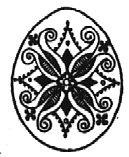The art of making these eggs goes back to approximately the year 988, when the Ukrainians accepted Christianity. Before that, according to Ukrainian legend, people decorated eggs believing that great powers were embodied in the egg. To them, eggs symbolized the release of the earth from the shackles of winter and the coming of spring with its promises of new hope, new life and prosperity, and that as long as pysanky were decorated, goodness would prevail over evil throughout the world.
world.
The symbols took on many different shades concerning good luck and tightening the chain on ‘evil' in the world....Must not be too many made??? Eh? Many ancient Ukrainians believed the eggs possessed magical powers and that wealth could be obtained by decorating the eggs with certain symbols. When Christianity was introduced into the Ukraine, 700 -800 years ago, the symbols changed and others were added to reflect Christianity, the Resurrection and a promise of eternal life..
The process - although looking difficult - is very simple. It is a long process and takes a steady hand, time, and patience. Once completed, you have a real sense of accomplishment.
Begin using a clean smooth white egg, a candle, beeswax, and the tool, which is called a ‘kistka'. (I will give links or addresses where these supplies can be purchased.) The egg must be at room temperature. If the egg is cold or even cool, when the wax is applied, it can come right off. Just like our skin has pores to breathe, the egg also has pores. When the egg is covered with the wax, it fills the pores, therefore preserving what is underneath. Be sure your hands are washed, clean and dried. Any oils or sweat from your skin can cause the dyes not to take or smear.
The kistka is a small wooden dowel with a hole drilled through one end where a small copper funnel-like cone is inserted and wrapped secure by copper wiring. It is a conductor of the heat and the tip comes in different sizes so the lines may be fine to thick as it's put upon the egg. The beeswax is a softer wax..and is inserted into the wide part of the funnel. Then the kistka is heated by direct contact to the candle. The design begins usually by encircling a line completely around the egg and it becomes a series of adding or connecting lines in a geometric pattern. Sometimes..flowers, and other pictures and symbols are added to the eggs (to be explained later.)
After the initial design is put on the egg with the wax, the egg being white itself be sealed by the wax. It is then put into the lightest color dye (usually yellow)...(These dyes are chemical called analine dyes and are not edible and are permanent.) When the egg is removed from the dye, everything under the wax will remain white because it is preserved by the wax on it. The next step is to fill in with wax everything you want to keep yellow...whether it is filling in an area or drawing something new on will be protected. Then it is put into the next darker shade and so on and so on until the process is done and the egg is nearly covered with wax.
When finally complete, the egg is heated to the side of the candle until the wax begins to melt and is wiped away with a soft paper towel or clean rag to reveal the beautiful design underneath..The egg is then covered with a thin coat of varnish or polyurethene spray to protect it and give it a shine. I have a wooden rack made with nails sticking up on which to dry them.
The best part of demonstrating this to any group, is to watch their faces when they see this egg completely covered in black wax and I melt and wipe away the wax to reveal this marvelous treasure underneath. It never ceases to amaze me. And no two eggs made are ever totally alike. It's like a snowflake..in a way. Even if it's the same design, the dye may not color it the same or I may add or take away something little. They are certainly unique and one-of-a-kind works of art.
Colors & their meanings:
- Black - Remembrance
- White - Purity
- Lavender - Reverence/Royalty
- Yellow - Spirituality
- Green - Youth/Growing
- Red - Beauty/Love
- Orange - Endurance/Strength
- Brown - Earth
- Blue - Sky/ Good health from good air



